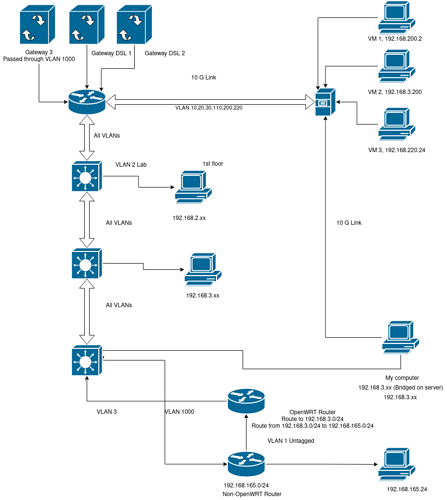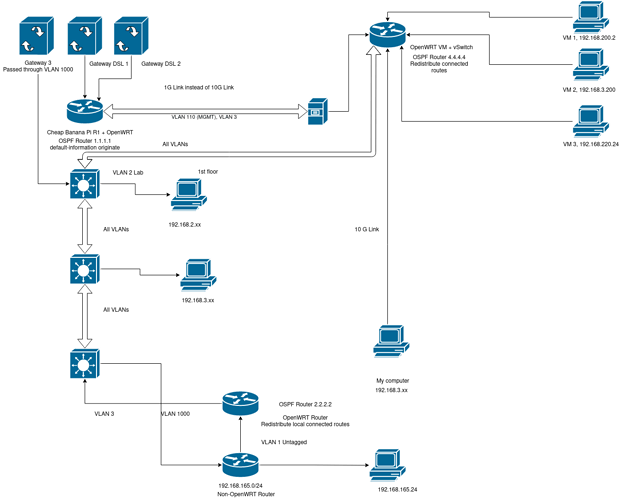Ahoy my friends.
Today i'd like to get rid of all the mess i have on my network.
It's been a while since i have upgraded my server. There are almost 100 virtual machines running on it, and it's a 32 Core 128GB ECC RAM EPYC machine.
My actual router is a dual socket based Westmere system, using 2x Xeon X5650 and 16GB ECC RAM.
The power consumption of my server is around 200W, and of my router 250W.
So i was thinking about moving the cpu intense part onto my server, and using my router for mwan3 load balancing only, and as Management-VLAN gateway as well as default gateway for everything else.
So that's how my network currently looks like. A lot of routers because i got my brother living here, having his own internet connection. So the VLAN 1000 is passed through all routers and floors to his room, using PPPoE. Also he got a router connected to my network, using OpenWRT, in order to establish routes between mine, and his network.
Also my network is growing, and there will be additional routers in the future as well.
Currently i am studying for my CCNP certification, and i would like to implement it's related topics somehow in my network, and maybe get some benefit of it. So i thought i may use OSPF for my home network in this case. This way i could get rid of the power consuming router, and use my old and cheap OpenWRT Banana Pi R1 again, for acting as a gateway only. The cpu intense work, like 10G routing, i would like to move it onto an OpenWRT VM in my server, and connecting my almost 100 virtual machines onto it, using vSwitches as well, instead of spreading all these VLANs accorss my network. This way i could dynamically redistribute the connected routes on my server to the rest of the network in order to be able to access them, without having static routes (That's what i currently have on my machine).
Here how it is meant to be, in my opinion.
So in conclusion, i would like to get rid of my old router, and move the cpu intense stuff onto my server, which has a lot of resources left.
Also i'd like to implement techniques, learned from my CCNP preparations in order to get used to them, and have a little bit of practice and fun.
Is it maybe even better to use different areas, or even stub areas? Maybe in order to provide route summarization for all the 192.168.x.x/24 subnets, for a 192.168.0.0/16 route?
The gateway router should simply provide the default route only, using default-information originate
I am looking forward for some advices in my case! At the moment i got almost 100mbps on broadcast traffic.
Thanks in advance!

